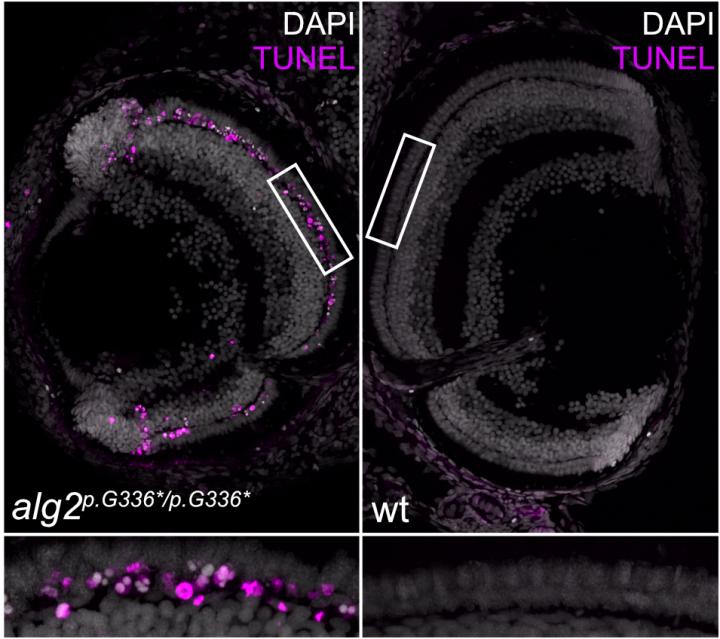Heidelberg researchers model complex metabolic disturbance
A rare genetic defect that affects the so-called ALG2 gene can cause serious metabolic diseases in humans. It does so through the defective formation of proteins and sugar molecules. Until now, its rareness and complexity made it difficult to study this congenital glycosylation disorder. A research team led by Prof. Dr Joachim Wittbrodt and Dr Thomas Thumberger from the Centre for Organismal Studies (COS) of Heidelberg University has finally succeeded in introducing the underlying mutation in the ALG2 gene in a fish model, thus allowing the causes of these complex diseases to be studied at the molecular level.
Human cells are kept alive by the activity of millions of proteins. As they mature, these proteins must be modified in a myriad of ways, such as through the addition of sugar molecules – a crucial change for proper function. Defects in this sugar-adding process, also known as sugar decoration, are often lethal at the very early stages of development. As Prof. Wittbrodt explains, in rare cases a genetic defect causes sugar-addition deficiencies, which then manifest as congenital disorders of glycosylation. “Correct protein glycosylation requires a number of enzymes functioning together like clockwork,” states the researcher. The ALG2 gene has an especially important task in this process. It codes an enzyme needed for the correct branching of the sugar chain. If this process is disturbed, patients appear unaffected at birth but develop problems in different organs, such as the eyes, brain, and muscles, during early childhood.
The team led by Prof. Wittbrodt and Dr Thumberger used the CRISPR/Cas9 gene editing scissors to introduce an ALG2 mutation in a fish model, the Japanese rice fish or medaka. “Fish are particularly good models for these disorders because they develop outside the mother, making them very suitable for studying early embryonic defects,” explains Dr Thumberger. In addition, the genome of the Japanese rice fish can be edited efficiently and precisely. “Our fish are genetic twins, so to speak, so the effect of individual changes can be directly identified as compared to non-genetically altered fish.”
Although the evolutionary distance between humans and fish is vast, the researchers report many of the same symptoms in the fish model that appear in ALG2 patients, including specific neuronal defects. They were surprised by the results yielded by the analysis of the total medaka organism, which took into account the full spectrum of different cell types. “Although all cells of the fish showed the same reduced ALG2 activity, some cell types were more affected than others,” states Prof. Wittbrodt. In the retina of the fish eye, cone cells needed for colour-sensing were unaffected, but there was a progressive loss of rod cells needed for vision in low light, thus rendering the fish night-blind. Now the researchers hope to identify the proteins that cause the rod cells to die off because of diminished sugar binding.
“Our studies on the medaka fish model showed that all symptoms could be prevented by supplying fully functional ALG2 mRNA – the blueprint for producing the correct ALG2 enzyme. We were able to effectively reverse the genetic defect in the fish model. That means that we can now systematically analyse the individual function areas of the ALG2 enzyme. We are particularly interested in the cell type-specific response in the context of the whole organism,” stresses Joachim Wittbrodt. Building on this research, the Heidelberg research team plans to study the molecular mechanisms and causes for the development of such complex metabolic diseases in humans.
###
In addition to the Heidelberg team at the COS, researchers from the Center for Molecular Biology of Heidelberg University (ZMBH), Heidelberg University Hospital, and the Max Planck Institute for Dynamics of Complex Technical Systems in Magdeburg joined in the study. The research work was funded by the German Research Foundation. The results of the study were published in the journal “Development“.
Media Contact
Joachim Wittbrodt
[email protected]
Original Source
https:/
Related Journal Article
http://dx.





